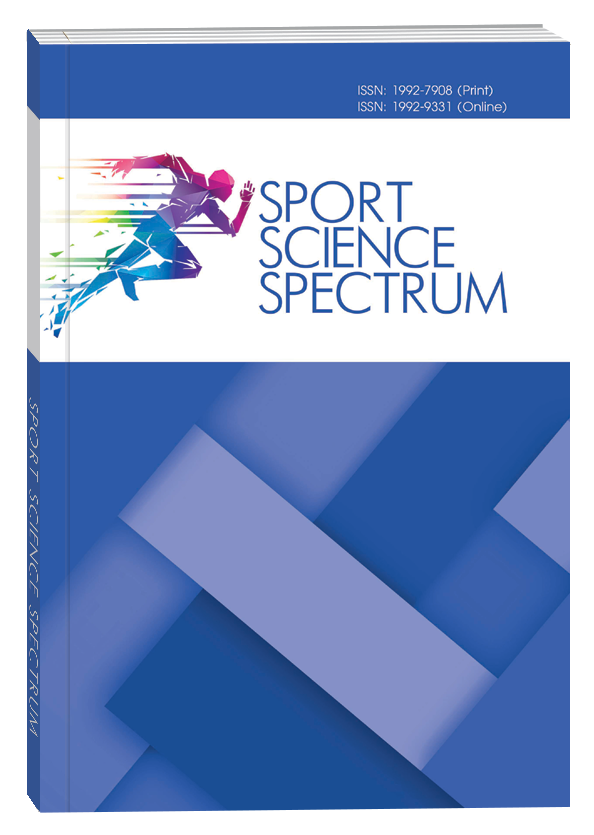TYPES OF STUDENTS’ MOTOR ACTIVITY AT THE SPORTS GROUNDS OF EDUCATIONAL INSTITUTIONS
DOI:
https://doi.org/10.32782/spectrum/2024-1-17Keywords:
physical activity, sports grounds, schoolchildren, educational institutionsAbstract
Introduction. According to the World Health Assembly, more than 80% of adolescents aged 11–17 do not follow the current international recommendations for a minimum of one hour of physical activity per day (among girls, it is 85% and 78% among boys). In the context of increasing physical activity, it is advisable to increase the efficiency of the use of sports facilities in educational institutions of various levels. Today, in our country, the network includes sports facilities for more than 160 sports and active leisure activities. The problem of the condition of sports grounds and their intended use is only fragmentarily considered in research. It is worth noting the growing requirements not only to the design but also to their intended use, and therefore, it is important to study the peculiarities of school students’ use of sports grounds of educational institutions, especially in areas affected by hostilities, one of which is Sumy. Objective. To define types of students’ motor activity and peculiarities of using open sports grounds at the educational institutions of Sumy. Methods. The analysis of scientific and methodical literature, the method of a survey for the estimation of types of students’ motor activity at open sports grounds, methods of mathematical statistics. Results. In Ukraine, there are specific problems related to the use of sports grounds by school students. Limited resources, outdated infrastructure, and varying awareness of the importance of physical education cause these problems. As a result, many school students do not have adequate opportunities to engage in regular physical activity, which negatively affects their overall development and well-being. The findings showed that the most popular out-of-school time physical activities among the relevant group of children are outdoor games, football, walking, and exercises with the use of gymnastic equipment. Children, with few exceptions, were mostly evenly involved in various types of physical activity in different time periods.
References
Борек З. Польський досвід оздоровчо-рекреаційної діяльності з використанням спортивних споруд типу «Орлик». Спортнаука України. 2015. № 2. С. 48–54.
Блажиєвський Г., Савитська Н. Актуальні проблеми функціонування спортивних
споруд та ефективність їх використання. Фіз. виховання та спорт у контексті держ. програми розвитку фіз. культури в Україні: досвід, проблеми, перспективи. 2014. № 1. С. 16–19.
Векліч В. Оцінка матеріально-технічного забезпечення фізичного виховання у загальноосвітніх школах України. Фіз виховання спорт та культура здоров’я у сусп-ві. 2019. № 4 (44). С. 47–52.
Гаркуша С. Характеристика стану здоров’я сучасної учнівської та студентської молоді в Україні. Вісник Чернігівського національного педагогічного університету. 2013. С. 92–94.
Кінаш І. Інфраструктура фізичної культури та спорту України: сучасний стан, проблеми розвитку, способи вирішення. Бізнес Інформ. 2013. № 1. С. 174–177.
Крижанівська О. Фізична культура студентів в Україні: сучасний стан та перспективи. Фіз. виховання спорт та культура здоров’я у сусп-ві. 2018. № 3 (37). С. 35–40.
Мандюк А. Теоретико-методичні основи формування культури вільного часу школярів з використанням різних форм рухової активності: дис. … докт. наук з фізичного виховання та спорту: спец. 24.00.02 «Фізична культура, фізичне виховання різних груп населення»; Львівський державний університет фізичної культури імені Івана Боберського. Львів, 2021. 345 с.
Мандюк А., Ріпак М. Оцінка функціонального стану відкритих спортивних майданчиків м. Львова. Вісн. Черніг. нац. пед. ун-ту. 2018. № 152 (2). С. 102–105.
Семененко В., Трачук С., Теліус В., Малишева О. Європейський досвід організації фізичної активності дітей та підлітків: проблематика і перспективи. Теорія і методика фізичного виховання і спорту. 2023. № 3. С. 56–62. DOI: 10.32652/tmfvs.2023.3.56–62.
Томенко О., Матросов С., Москаленко Т. Стан та функціональне призначення спортивних майданчиків закладів освіти Сумської міської територіальної громади. Вісн. Прикарпат. нац. ун-ту. 2023. № 41. С. 81–86.
Karimov F. Scientific and Methodological Bases of Normalization of Loads in Physical Education and Mass Sports-Health Training. EUR J BUS STARTUPS OPEN SOC 2 2. 2022:24-8.
King AC. Community-based approaches to reducing health inequities and fostering environmental justice through global youth-engaged citizen science. Int J Environ Res Public Health. 2021. 892 р.
Krutsevich T., Pangelova N., Trachuk S., Ivanik O. Motor activity of the male and female population in modern society. Journal of Physical Education and Sport. 2019. № 19 (3). Р. 1591–1598. DOI: 10.7752/ jpes.2019.03231.
Kolbe LJ. School health as a strategy to improve both public health and education. Annu Rev Public Health. 2019. № 40. Р. 443–463.
Hammami A. Physical activity and coronavirus disease 2019 (COVID-19): specific recommendations for home-based physical training. Manag Sport Leis. 2022. № 27 (1–2). Р. 26–31.
Promoting physical activity through schools: a toolkit. Geneva: World Health Organization; 2021. URL: https://apps.who.int/iris/ handle/10665/350836.
Promotion of physical activity in the education sector. Current situation and good experiences of European Union Member States in the WHO European Region. 2018. URL: http://www.euro.who.int/__data/assets/pdf_file/0007/398995/Education-Factsheet_RUS.pdf?ua=1.
Semenenko V., Trachuk S., Telius V., Malysheva O. European experience of organizing physical activity of children and adolescents: problems and prospects. Theory Methods Phys Educ Sports. 2023. № 3. Р. 56–62.
Syrovatko Z., Yefremenko M., Anikeienko L, Bilokon V., Korol S. Strengthening students’ health in the process of sports and health tourism engagement. Wiad Lek. 2021. Р. 1478–1482.
Suha Yuksel H., Neşe Şahin F., Maksimovic N., Drid P., Bianco A. School-based intervention programs for preventing obesity and promoting physical activity and fitness: A systematic review. Int J Environ Res Public Health. 2020. № 17.1. Р. 347.





